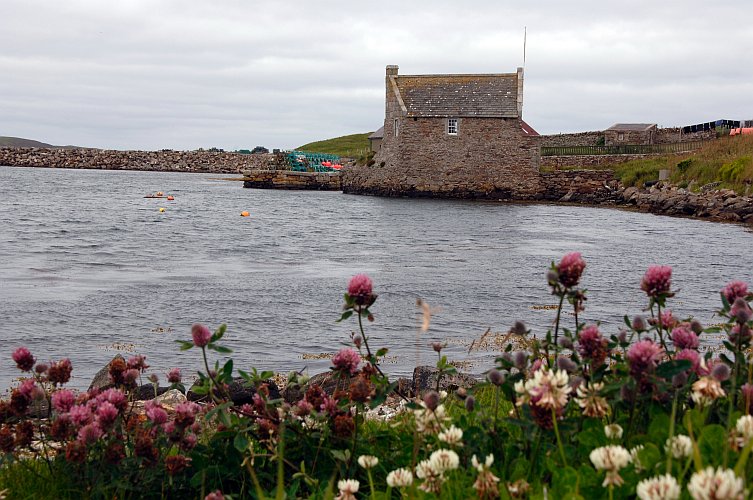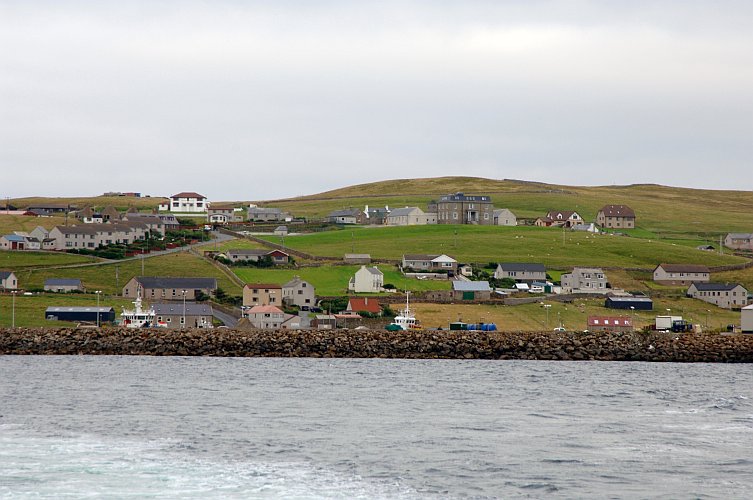Welcome to Whalsay
Whalsay with its heritage rooted in fishing, is the centre of this industry in Shetland. Important archaeological sites and a wealth of birds, seals and wild flowers make it a fascinating destination for a day trip or a longer stay.
Just five miles long and two miles wide, Whalsay has easy and attractive coastal walks with magnificent cliff scenery. From the highest point, the Ward of Clett (393 feet), there’s a panorama of the east coast of Shetland.
 Bod in Whalsay
Bod in Whalsay
 Whalsay also boasts Britain’s most northerly golf course, Shetland’s museum to the German merchants of the Hansa and a modern, well-equipped leisure centre with heated swimming pool and snooker house where visitors are welcome.
Whalsay also boasts Britain’s most northerly golf course, Shetland’s museum to the German merchants of the Hansa and a modern, well-equipped leisure centre with heated swimming pool and snooker house where visitors are welcome.
The tidal sounds and off-lying rocks around Whalsay are among the best places in Shetland to see porpoises and occasional dolphins, minke whales and orcas. So keep a lookout during the ferry crossing and you may see why the Vikings called it “Hvalr-øy” – the island of whales.
The ferry terminal for Whalsay is at Laxo, a 20-mile drive north of Lerwick. The crossing to Symbister takes 25 minutes and the service is frequent, although booking is advised in the peak season.
Accommodation on Whalsay is limited so it’s best to book ahead. The Oot Ower Lounge at Livister offers bar meals and visitors can buy snacks in local shops or at the leisure centre.
Stone Age and Iron Age Relics
People have lived in Whalsay for at least 4,000 years. Traces of former settlement range from hilltop burial cairns and prehistoric field boundaries to nationally important monuments such as the two spectacular Neolithic houses of Yoxie and the Beenie Hoose at Pettigarth Field excavated by Charles Calder and Whalsay-born John Stewart in the 1950s.
These croft houses evolved over 100s of years. The flourishing community built its own burial place overlooking the fields.
There are indications that Whalsay once had two brochs, dating from just before the time of Christ. Whalsay was clearly strategically important. The brochs are now in ruins. An even earlier Iron Age fortification is the blockhouse on a holm in the Loch of Huxter.
Other archaeological remains include burnt mounds, foundations of prehistoric dykes buried under peat, and traces of Bronze Age houses at the Loch of Sandwick.
Stumps of Ancient Mountains
The rocks of Whalsay are schist and gneiss, formed at high temperature and pressure beneath mountains which were eroded away hundreds of millions of years ago. In places you can see large fragments of the original rocks – known as xenoliths – mixed up with the formerly-fluid mass of granitic gneiss.
On the north-east coast are outcrops of crystalline limestone and contorted calcium silicate bands. The landscape of Whalsay has been carved and smoothed by successive ice ages and the coastline etched by the incessant battering of the sea.
Symbister’s Bustling Harbour
The harbour at Symbister is the hub of this successful fishing community of around 1,000 people - and a constant source of interest to islanders and visitors alike.
 Symbister, Whalsay
Symbister, Whalsay
 Craft owned and crewed by local families throng the sheltered dock, from the smallest creel boats to huge pelagic trawlers - some of Europe’s largest fishing vessels. Nearby, a modern factory processes whitefish for export, while next to the Whalsay Boating Club which welcomes visitors, are the remains of a former herring curing station.
Craft owned and crewed by local families throng the sheltered dock, from the smallest creel boats to huge pelagic trawlers - some of Europe’s largest fishing vessels. Nearby, a modern factory processes whitefish for export, while next to the Whalsay Boating Club which welcomes visitors, are the remains of a former herring curing station.
The inner harbour is crowded with colourful dinghies and the distinctive “Shetland Model” boats which compete in local sailing and rowing races. The lines of these double-ended skiffs reveal their Viking origins.
The beach below the road around the head of the bay is partly man-made and was formerly used to dry salted cod and ling during the heyday of the line fishery from sixerns - open, six-oared boats - in the 18th and 19th centuries.
The German Merchants
For hundreds of years the salt fish trade was in the hands of German merchants of the Hanseatic League. The fascinating museum in the Symbister Pier House tells how ships from Hamburg, Bremen and Lubeck sailed to Shetland every summer, bringing seeds, cloth, iron tools, salt, spirits, luxury goods and hard currency.
This picturesque old building, restored with its dock and cargo hoist, was one of two Hansa böds, or warehouses, in Whalsay until the Germans were forced out by import duties after the 1707 Treaty of Union between England and Scotland.
The Auld Haa
Not all trade was legal. Tradition says a smugglers’ tunnel ran under “Bremen Strasse”, the road outside the böd, to the cellars of the Auld Haa, the former home of the Bruce lairds. According to legend, soil in the garden was shipped from Spain as ballast after the laird’s ships had discharged fish cargoes there.
Symbister House
The Bruce family acquired most of Whalsay and oppressed the islanders for over 300 years. But they virtually bankrupted themselves building Symbister House, or the New Haa. Now part of Whalsay Junior High School, this is the finest Georgian mansion in Shetland. It’s built of granite blocks, rafted from a quarry in North Nesting, three miles away across a tide race. Despite the use of forced labour, the building cost over £30,000, a fortune in the early 1800s. The estate’s finances never recovered and the last resident laird died in 1944.
The New Haa had courtyards, stables, byres, a farmhouse, a mill, a dovecote and even a “high-rise”, three-seater, outside toilet. The local history group plans to convert part of the outbuildings into a museum and heritage centre.
Sodom and Hugh MacDiarmid
For most of the 1930s the Scots Communist poet Christopher Grieve (“Hugh MacDiarmid”) lived in Whalsay. He was poor, little-known outside literary circles and regarded in the island as an oddity, although his wife Valda and son Michael were well-liked.
In the croft house of Sodom (from the Old Norse su∂r-heimr - the southerly homestead) this often tormented genius wrote much of his finest poetry (including On a Raised Beach) and, via the Whalsay post office, conducted furious correspondence with the leading writers and thinkers of his generation.
Grieve was called up for war work in 1942 and never returned to Whalsay. His former home is now a camping böd, run by Shetland Amenity Trust.
Walking With Wildlife
For thousands of years beachcombing has been a favourite Whalsay pastime, as is shown by the astonishing profusion of shoreline placenames.
As well as flotsam, the coastal walker will encounter most of Shetland’s seabirds, including puffins. Ducks and waders gather at the shallows behind the beach at Symbister and at the houb (lagoon) on Kirk Ness. Inland lochs harbour several pairs of breeding red-throated divers. In spring and autumn there are often good “falls” of migrating birds from Scandinavia and further afield.
The shore pastures are carpeted in summer by the pink flowers of thrift and campion, and the blue of spring squill, while at the Geos of Yoxie on the east side one of Shetland’s rarest plants grows – Sea Aster – but be careful when viewing it from the cliff!
Below the tideline, there is a profusion of sea life in the rockpools of this unpolluted coastline. Otters are common but shy, except around Symbister where they’ve become used to harbour traffic and are sometimes seen at close quarters.
Follow the Countryside Code: Wherever you go in The Bonnie Isle, please use stiles, close gates behind you, avoid damage to crops and fences, and don’t disturb livestock or wildlife. Dogs must be kept under control.
Some Useful Information
| Ferry Booking Office: | Symbister, Tel: 01806 566259 |
| Shops: | Symbister, Harlsdale, Sodom and Booth Park |
| Petrol: | Symbister and Booth Park |
| Public Toilets: | Symbister, Skaw and South Play Park |
| Post Office: | Harlsdale |
| Public Telephones: | Symbister (ferry terminal) and Brough crossroads |
| Golf Course: | Skaw, Tel: 01806 566483 or 01806 566481 |
| Leisure Centre & swimming pool: | Symbister, Tel: 01806 566678 |
| Church: | Brough, (church hall Symbister) |
| Doctor: | North Park, Tel: 01806 566219; Doctor Marshall, Tel: 01806 566501; Relief Doctor, Tel: 01806 566203 |
| Police Station: | Gardentown, Tel: 01806 566432 |


